Product Reviews

Torqeedo’s Travel 1003
Clean, quiet outboard power
From Issue September 2015
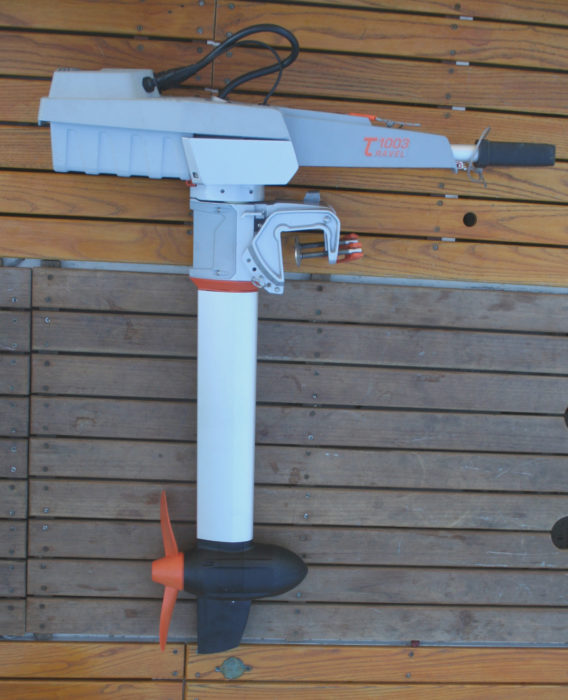
Torqeedo’s outboards with ratings up to an equivalent of 8 hp are designed without anti-ventilation plates. The foil-sectioned shafts on all but the smallest outboard aid in keeping surface air from getting to the prop.
F or decades I resisted boating under power and took pride in getting where I wanted to go under my own steam or under sail. That changed when I had kids: they were too young to help with rowing, the summer winds are usually too light for getting anywhere by sailing, and the joy of hanging out with them meant more to me than manning the oars. I built a Caledonia yawl with them in mind and installed a motor well. I bought a small 2.5-hp Yamaha outboard—a four-stroke to avoid leaving behind a cloud of stinky blue smoke typical of two-stroke outboards—but it still had an environmental impact in both the fuel it consumed and the peace it disturbed. For the past 11 years, Torqeedo has worked to eliminate both with their electric motors. In 2010 I tried the smallest motor they produce, the Ultralight, on a kayak. The equivalent of a 1-hp motor, the Ultralight would drive the kayak at an impressive 4 ¼ knots and an exciting 5 ½ knots after I added a foil-shaped fairing to the tubular shaft.
The two Travel motors are the smallest of the Torqeedo outboards. The Travel 503 is rated as the equivalent of a 1.5-hp gas motor; the Travel 1003, the equivalent of a 3-hp. I tried the Travel 1003S (S for short shaft) on three different boats: the Caledonia yawl, a Whitehall, and an Escargot canal boat. Torqeedo lists the shaft length for the Travel 1003S at 62.5 cm (24 5/8″), a measurement from the bearing surface of the mounting bracket to the center of the prop. On gas outboards the shaft length is commonly measured to the anti-ventilation plate, not the propeller axis; the Travel 1003 has no anti-ventilation plate, but I measured 46.5 cm (18 ¼″) to where one would be. That’s roughly the maximum span between the bottom of the hull and the site for the mounting bracket. The shaft length for the Travel 1003L is listed as 75cm/29.5″.)
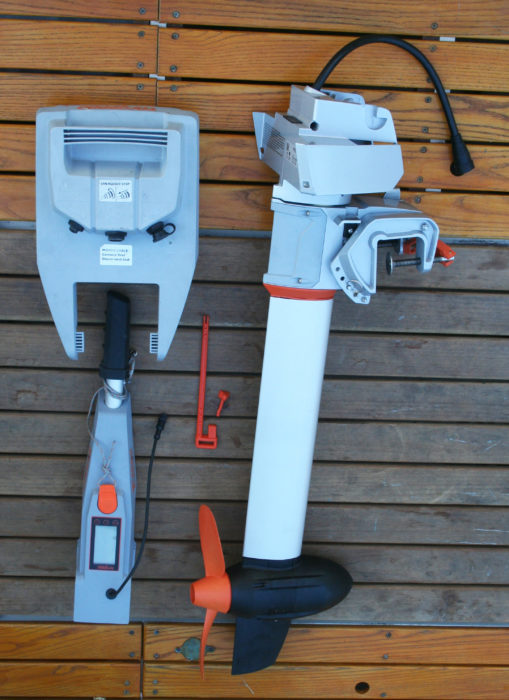
Disassembling the motor makes it much easier to stow out of the way when it’s not needed. The long pin locks the battery pack in place.
The Travel 1003 weighs 30 lbs, 7 lbs less than my Yamaha, and it separates into three pieces—the tiller and its computer just shy of 2 lbs, the battery at 12 lbs, and the lower unit about 16 lbs—making it a whole lot easier to move around, mount, and stow.
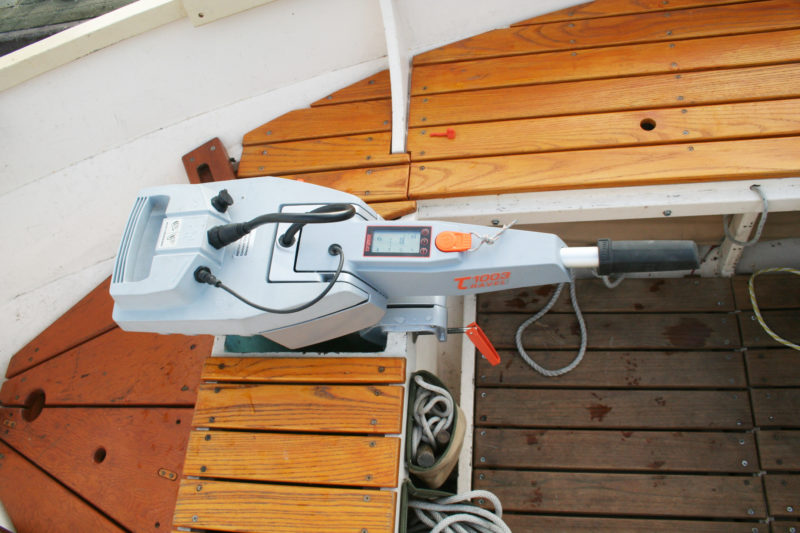
Set in the motor well of a Caledonia yawl, the Travel 1003 S reached a maximum speed of 5 knots. The orange pin on the bench locks the shaft when the boat’s rudder is used for steering. The orange tab on the tiller is a magnetic kill switch.
I used the Travel 1003 first on my Caledonia yawl, a 19′ 6″ x 6′ 2″ double-ender. With the motor at full throttle, the yawl peaked at 5.0 knots. My Yamaha logged a top speed of 5.8 knots. (I have an electric trolling motor rated at 40 lbs of thrust, but it falls so far short of the Travel 1003 that I don’t bother including it in these trials.) A built-in computer with GPS shows the percentage of battery charge and the distance it will take you at the speed indicated. At full speed a full charge had a cruising range of 2.4 nm. At 4 knots that range increased to 6.3 nm, at 3 knots 9.5nm, and at 2 knots 15.6 nm. The speeds and ranges I recorded were consistent with Torqeedo’s data for the Travel 1003 .
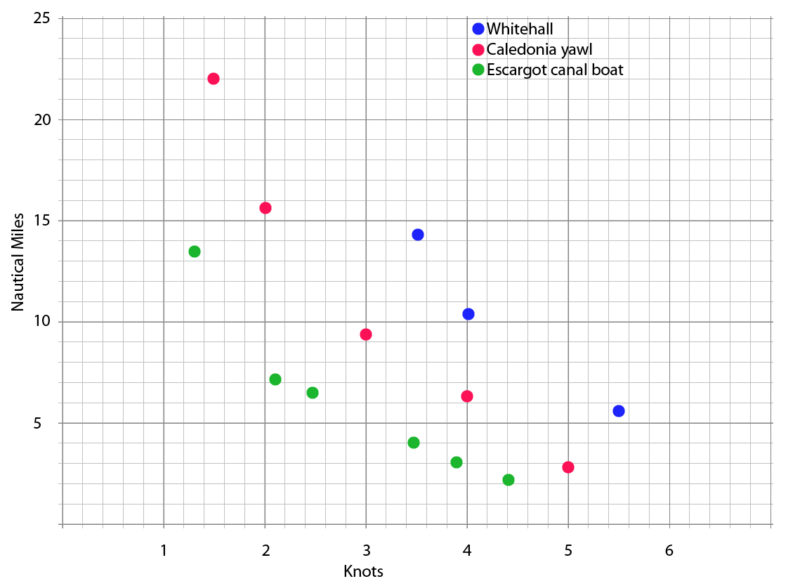
Ranges predicted by the Travel 1003 for a full battery charge with three boats at various speeds
There is a slight lag in the response to the throttle, and the motor will ramp up to the selected speed rather than apply full power immediately. That keeps the boat from lurching about, and, I imagine, prolongs the life of the motor and the boat. Even with the lag and ramp-up, I was impressed with how quickly the Travel 1003 could bring the yawl from 5 knots at full speed ahead to a dead stop: just 3 seconds and less than two boat-lengths.
The Travel 1003 operates in reverse, and a latch keeps the shaft locked down to prevent the prop from climbing. The yawl made 3.5 knots with the Travel 1003 in reverse at full throttle. (The Yamaha does not have reverse but rotates through 360 degrees, as does the Travel 1003.) Releasing the latch allows the motor to kick up over obstructions while moving forward and to be raised to reduce the drag while rowing or sailing. A removable pin will lock the Travel 1003 facing straight ahead for steering with a boat’s rudder.
The Travel 1003 is quiet but not completely silent. It has a whine that rises in pitch and volume as the throttle gets cranked up, but even at its loudest it is neither an impediment to a conversation nor anywhere near as loud as my gas outboard. It doesn’t vibrate either, so there’s no rattling anywhere on the boat. Its relatively quiet operation at low-to-moderate speeds is great for dinner cruises. I’m used to gauging speed by the racket my gas motor makes when moving along at a good clip, but even at full throttle, the sound the Travel 1003 makes belies how fast the boat is moving; it’s more like sailing than motoring.
On my 14′ lapstrake Whitehall the Travel 1003 peaked at 5.5 knots. (I didn’t—and wouldn’t—try to mount the heavier Yamaha on the transom—there’s little buoyancy in the stern.) I also did trials with my son’s 19′ 6″ x 6′ Escargot canal boat , weighing over a half ton with gear and two of us aboard. It brought the canal boat up to 4.4 knots, just slightly slower than the Yamaha at 4.7 knots.
Torqueedo claims on its website that the Travel 1003 “can do everything a 3-hp petrol outboard can, plus it’s environmentally friendlier, quieter, lighter, and more convenient.” The latter half of that is certainly true, but I’d suggest the former isn’t a good comparison to make. According to the owner’s manual, my Yamaha has a maximum output of 2.5 horsepower or 1.8 kW at 5,500 rpm, while the Travel 1003 display reads 1,000 watts (1.0 kW) at full throttle with maximum propeller speed listed by Torqeedo at 1,200 rpm. Going by the numbers gets murky. The Yamaha rating is for propeller-shaft horsepower, and the Torqeedo rating is for input power with propulsive power at 480 watts; static thrust is listed as 68 lbs, but that’s not calculated the same way as it is for trolling motors. Torqeedo offers some clarification on the terms and their equivalence with gas outboards, but my sea trials for top speed didn’t bear that out for the Travel 1003, even up against a 2.5-hp instead of a 3-hp gas outboard.
I haven’t made precise mileage calculations for my gas outboard, but one measurement I made on Google Earth for a passage on a full tank of gas (0.24 gallon) was 6 miles, running at about two-thirds throttle. That’s 25 miles per gallon. At a comparable speed the Travel 1003 will cover about the same distance. To extend the range of my gas outboard, I’ll carry two 2.5-gallon gas cans for a range of 125 miles. For the Travel 1003, an extra battery, at $650, brings the range to 16 miles. For charging away from home, Torqeedo offers a 50-watt solar charger for the Travel 1003, and it is possible to recharge its battery from an in-board 12-volt system. In my experience recharging was an overnight process, only slightly more than the 14 hours listed by Torqeedo; the latest models have cut that time in half. While I don’t have to think much about my range with my gas outboard, the Travel 1003 would require some thoughtful planning to achieve the same range for an extended cruise. If your outings with the Travel 1003 aren’t pushing the limits of its range, you can use the energy for other purposes: its battery has a port you can use to charge electronic devices.
Christopher Cunningham is the editor of Small Boats Monthly.
Torqeedo distributes its products through a network of dealers and offers the Travel 1003 for $1,999 with a two-year warrantee.
Thanks to reader Elliot Arons for suggesting this review.
A Cautionary Tale
When I tested the Travel 1003 on my Whitehall, I put thin plywood pads on the varnished transom to protect it from the motor’s mounting bracket and turned the screws down as tight as I could, knowing they wouldn’t leave their mark on the mahogany. The Whitehall isn’t meant to carry an outboard, let alone maintain trim with the weight of a motor and its operator well aft, so I sat as far forward as I could and still keep a hand on the motor’s tiller. I made a few runs, back and forth in a protected canal, some at full speed. On the last run, while at full power, the tiller slipped suddenly from between my fingers and the motor turned 90 degrees, pushing parallel to the transom. It then twisted almost to horizontal and then slipped off the transom. I lunged for it as it went overboard and got a hand on the tiller. The magnetic kill switch disengaged and the prop stopped turning. I thought I had averted disaster, but as the boat carried forward, the angle between the tiller and the motor opened up and they parted, just as they’re meant to do if you’re disassembling the pieces for transport or storage. The cable from the tiller didn’t have a connection strong enough to hold the battery and lower unit, and down they went. I was left holding the tiller, a bit stunned.
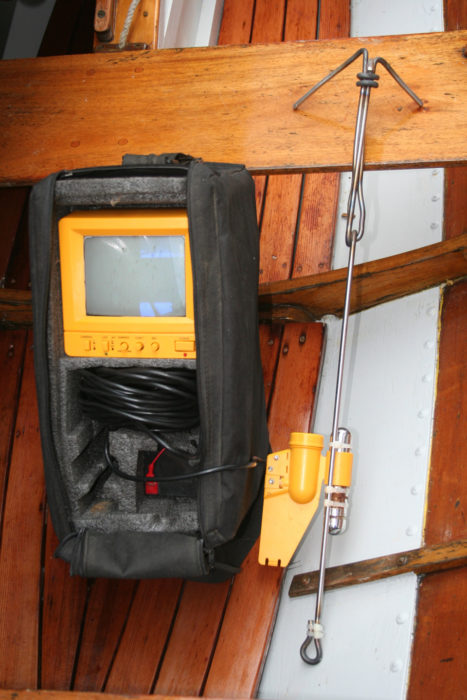
To recover the motor I needed to find it first, then snag it. The underwater video system and a hastily made grappling hook did the job.
I went home and made a grappling hook out of steel rod and connected it to my Harbor Freight underwater video camera. I was feeling hopeful about recovering the motor—it had gone down in a narrow stretch of water, and I had a pretty good idea of where it would have come to rest. Unfortunately, the water in the area was about 25′ deep and the light on the bottom was dim, so the video camera could show only a narrow swath of the sandy bottom. The next day I tried again, but it was too difficult to manage the boat and control the depth of the camera at the same time. I returned with my son Nate, and we were about to give up when he spotted the motor. It went in and out of the camera’s view, but after 20 minutes he got the hook on the power cable and brought the motor and battery up.
The Travel 1003 has an IP67 rating and is waterproof for 30 minutes at 1 meter, but not for two days at 25′. The red indicator light on the battery case blinked on a few times, and that was its last sign of life. I opened the case to get the water out of it and the damage to the batteries and the circuit board was evident.
I can’t fault the Travel 1003. I’m not sure what caused the sudden turn, but with the motor running at full power I should have had a firm grip on the tiller. The Travel 1003 can rotate 360 degrees and can be oriented parallel to the transom. My Yamaha is the same way and has, on two occasions, twisted its bracket a bit out of position when turned 90 degrees and gunned for tight maneuvering. Larger outboards may have stops to limit their steering range and lessen the chances of prying themselves off a transom. The plywood pads I used to protect my Whitehall’s transom may have lessened the Travel 1003’s grip, but if my calculation for the torque created—140 ft-lbs—is correct, it may have dislodged itself even without the pads.
Three precautions come to mind for small outboards that can rotate to 90 degrees on either side. A solidly anchored cleat along the edge of the transom where the motor is attached would serve as a stop for the clamps on the inboard side. Some commercially made pads for the inside face of the transom have a lip at the top meant to keep a loosened clamp from slipping off. (They require more time to get the motor in place; a couple of slots cut off-center alleviate that problem.) Secondly, a safety cable or chain can tether the motor to the boat. My Yamaha has a hole in the mounting bracket meant for a cable and includes a recommendation in the instruction manual to use it. The Travel 1003 has holes in the clamp screw handles that can serve as safety-cable attachment points; a note about using them as such would be a worthy addition to its user manual. Finally, hang on to the tiller.— CC
Epilogue (October 2, 2015)
While it was clear to me that an outboard capable of rotating through 360° has the potential to turn to 90°—parallel to the transom—and wrench itself out of position or tear itself off entirely, I didn’t understand what had caused the motor to turn in the first place. I found a likely explanation in the September/October issue of WoodenBoat magazine. That issue’s “Getting Started in Boats” feature is “A Small Outboard Motor Primer” by Jan Adkins. Jan describes “The Death Spiral,” a common accident in which the operator of an outboard skiff is thrown overboard by a sudden turn and often severely injured when the boat circles around. Here’s the cause of the spiral: “For any reason (inattention, slippery hands, a reflex to reach for something) the helmsperson’s steering hand leaves the outboard tiller/handle. Unequal resistance between the deep propeller blade and the shallow propeller blade exerts torque that twists the outboard to port. The small boat turns violently to starboard….”
In my case, I had a loose grip on the tiller and the motor twisted itself off the transom rather than cause a sharp turn to starboard. Because the boat hadn’t turned violently and I had been looking over the bow at the time, I don’t have a clear memory of which way the motor had turned (and I had revarnished the transom of my Whitehall) but the slight scars that remained indicated that the motor had indeed twisted to port. (The Travel 1003’s propeller has a right-hand rotation—clockwise when viewed from astern—typical of outboards and would twist to port. A left-hand prop would cause a boat to turn to port.)
My Yamaha has a screw that increases the friction in the mount to lock the motor in position if I’m using a rudder to steer. If I’m steering with the motor I maintain a little friction so I can steer well but don’t have to “micromanage” the tiller. The Travel 1003 uses a pin to lock the motor for using a rudder to steer and without the pin the motor can rotate freely. Even though the Yamaha can be adjusted for turning friction, I’ll be much more careful with both motors when using them to steer.— CC
Share this article
Join The Conversation
We welcome your comments about this article. If you’d like to include a photo or a video with your comment, please email the file or link.
Comments (10)
I have had Torqeedo Travel 1003 for several years. It has a strong battery and will push my Norseboat 17.5 for about 10 miles at 3.0 knots. As you say, it is not a good choice for extended multi-day trips where recharging may be difficult, but for a day trip or overnight it’s great.
Aside from the advantages you mention, there is no winterizing, spark plugs to foul, or fuel to spill. Best of all it starts with a twist of the throttle. I feel confident sending my kids or friends out without worrying about their ability to get a gas motor running.
The only drawback, as you point out, is the range, which I bet most of us never exceed anyway. The advantages are far more persuasive to me. If everyone was already using Torqeedos and the gas outboard was introduced as an alternative, I bet very few people would by one.
We have a 1003 that we use on our 28′ Stuart Knockabout which displaces 4,000 lbs. We have a removable side bracket made of very heavy stainless. We had 4-hp Yamaha 4-stroke on it for years and you you could go straight to full throttle. First time we tried that with the 1003, the incredible torque cracked the bracket! After we had it rewelded, we now accelerate slowly and never go to full throttle until the boat has some way on her. Full throttle is just shy of 5 knots and we usually run at 3 if the wind dies. Great motor! I only wish the tiller display was easier to read without glasses!
It should be noted that, unlike a gas motor, the Torqeedo must be removed when sailing. According to the manufacturer, it can not be freewheeled without damage to the motor. This is a pain, especially when one wants to go just a short distance before switching to sail. The motor must be taken off and stowed before sailing. I never worry about drag on my Caledonia, so I would rather leave the motor in the well, but it’s a no-go.
Question: Can the Torqeedo tilt up out of water if mounted on a transom?
Yes, the Torqeedo Travel can be tilted up out of the water just like any small outboard motor, so you can raise it for sailing, rowing, or coming ashore without having to remove it from the transom.
As a Torqeedo dealer and user on the Mississippi Gulf Coast, let me offer a clarification about the Travel 1003’s horsepower. The motor has a power consumption of 1000 watts at top speed, which is equal only to about 1 1/3 hp. While this keeps power consumption low, it also keeps the motor under 2 hp, which is useful for boats like the SolarSkiff that are designed following the US Coast Guard standards for watercraft with engines under 2 hp. However, Torqeedo claims a propulsive force equivalent to that of a 3 to 4 hp gas engine: its electric motor is more efficient at converting its 1000 watt input power into propulsive output power, hence the 3-4 hp “equivalency.” My wife and I had a chance to put this power claim to the test this summer. We crossed the Bay of St. Louis in a two-person SolarSkiff for a group picnic at some friends’ home across the Bay. Going over in the late morning, the winds were light. Coming back, however, the afternoon seabreeze predictably began to fill in and it wasn’t long before we were motoring back against 12-knot winds, gusting to 15, with whitecaps everywhere. The Torqeedo Travel 1003 had the power to keep us moving against the wind and waves with no problem: we can’t do that with a 55 lb-thrust trolling motor! While I can honestly say that 12-mph winds are about the top that I would plan to be out on the water in a small craft with a Torqeedo, it both had the power and the range we needed that day for the 6-1/2 mile round trip. I did take my Torqeedo battery charger in my dry bag, though, and plugged the battery in while we enjoyed lunch with our friends, just to make sure we had sufficient power for the return home.
The most I have run my battery down is to 20% of its maximum capacity, with the motor conveniently and automatically beeping reminder warnings when it hits 30%, 20%, and 10% capacity. With the new lithium-ion battery design, it fully recharged in only 5 hours. The 7-hour recharge with the new battery is for a recharge of a fully discharged battery, whether plug-in or solar.
Chris, Congrats on the outstanding, detailed piece on the Torqeedo and the performance comparison to your Yamaha. I believe the current Torqeedo is a breakthrough product. I broke a long-time promise to myself never to sell my 5-hp 2-stroke Johnson. But, at long last, its 46-lb weight had become too much; its occasional hard-starting caused by water in that miserable fuel known as ethanol had become discouraging, as had the endless pulls on the starter cord.
There is little to add to your piece but the following may also be of help to those considering purchase of a Torqeedo. In your photo of the disassembled motor, there is a small orange peg shown beside the larger orange rod used to secure the battery to the motor. Although I have not found mention of it in the owner’s manual, the orange peg is meant to be inserted through a hole in the motor’s top portion into a hole in the leg. It prevents the head from rotating so the motor can’t be turned as accidentally happened to you when you least needed it. This would be of most use in an application where the boat’s rudder is there to steer with. It would not be practical on the transom of a rowboat where rotating the motor is needed for steering.
Oddly, I recall reading an owner review of the Torqeedo in which he complained that the mounting screws loosened up and his motor fell off. For whatever reason, this may be something owners should check before every outing to ensure things are really, really tight. It was good of you to note there are holes in the clamp handles by which they may be secured to the boat. The owner’s manual should mention this aspect. In my own application on the transom of an inflatable, I have one of those locking devices that slides over the clamping screw handles and effectively prevents them from loosening in any threatening manner. I can imagine your experience was quite unnerving.
As a motor for an inflatable or dinghy to get one from dock to mooring and back, the Torqeedo is perfect. I have found that full-throttle operation for about 25-30 minutes takes the battery down to about 62% but recharging at home has the battery back to full charge in rather little time. When I had the chance to use the Torqeedo 1003 longshaft as a sailboat auxiliary, I found that it easily moved a 3100-lb keel daysailer when the wind died. Putting it on the side bracket was a relative pleasure because, when broken down into its three main components, weight is not an issue. (I have tied a line from the battery to the battery mount rod so the latter can’t be lost overboard.) About 15-20 minutes running at part throttle brought us back to the mooring. Again, recharging was quickly done at home. The key for such an application, as the Stuart Knockabout owner noted, is the motor’s torque. I believe an electric motor develops peak torque at 0 rpm and that is key to getting a boat moving and then keeping it going steadily. But speed should not be a priority.
After one season, about the only improvements I can think of would be larger numbers on the readout display, a less abrupt response to initial throttle input—new owners should practice gingerly when first starting out if in a slip—and a somewhat greater tilt angle to get the skeg completely out of the water. The absence of need to winterize, let alone worry about storing or discarding fuel, are obvious plusses.
The 1003 is about twice the $900 price listed by West Marine for a Mercury 3.5 hp. If one has the right application need, I’d say the Torqeedo is well worth it.
Thanks for your comments, Stan. The small steering fixing pin is mentioned in the Travel 1003 manual on pages 9, 15, and 26 (do a search for “pin”), but there isn’t an illustration that shows it clearly. The pin gets put in place before the battery and once the battery is locked with the large locking pin, the small pin is secured.
I have an Able , a Selway Fisher design, in which I have a permanently installed 6-hp Tohatsu outboard. The engine is mounted on the centerline in way of the keel and I leave it down (in neutral) when sailing. Being in the draft of the keel the drag seems to be minimal. I would like to replace this with a powerpod of some sort, faired into the keel. I was considering a Torqueedo 1003 which I would use the power head and the controller. I did note that the Torqueedo manual says not to leave the unit freewheeling in the water when sailing as there would be damage to the electronics of the system. I am assuming that this is because, when free wheeling, the motor becomes a generator, sending an electrical charge back into the system. If this is the case, would: A: diodes (to negate electrical feedback) solve this problem? B: A mechanical stop on the prop? C: A master switch to disconnect the power from the power head? I think that there are many of us out here looking for a way to modify existing trolling motors to power our small craft. Spending $6,000.00 on an Elco pod is out of reach for most of us. I belong to the TSCA here on Cape Cod and this is a topic of conversation quite frequently. Many freshwater reservoirs and lakes are off limits to gas engines, so this would open up sailing venues for a lot of us. I’d love some feedback on this.
Comments are closed.
Stay On Course
More From This Issue
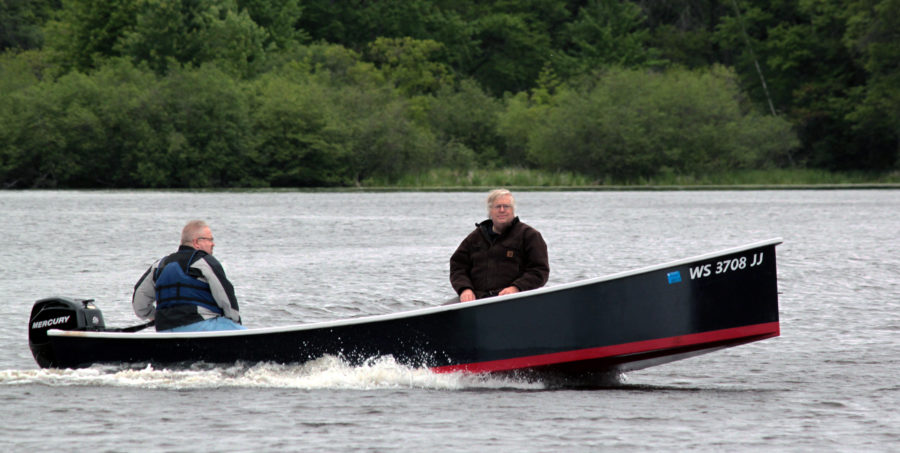
Boat Profile
I’ve had a copy of Phil Bolger’s book Boats With An Open Mind for a long time, and I’ve always liked the looks of the Clam Skiff he designed for…
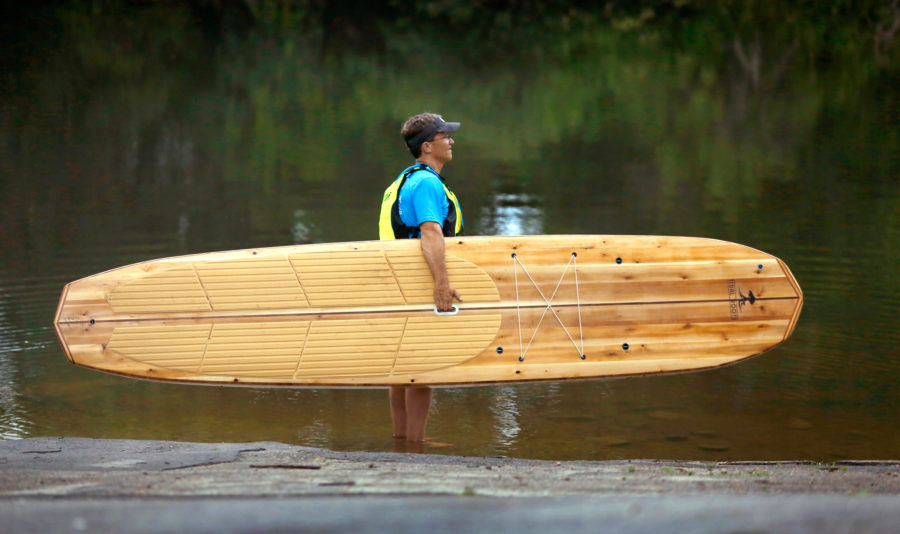
The Sand Bar by Tidal Roots
I was paddling on a placid Royal River with my four-year-old son Noah kneeling in front of me on a wooden Tidal Roots stand-up-paddle (SUP) board. The water hissed quietly…
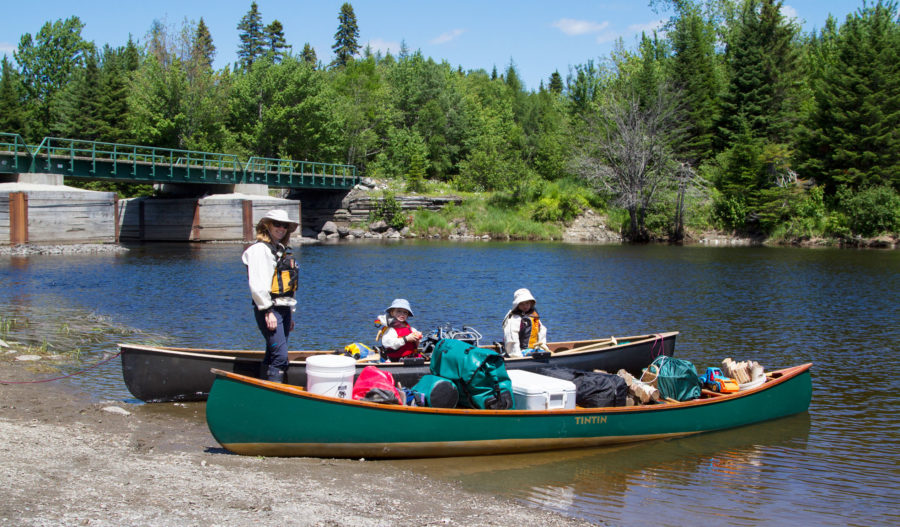
Investing in Memories
“Come TINTIN, come,” my four-year-old daughter hollered, then broke into a giggle. Her two-year-old brother threw back his head and let rip with his best belly laugh. We paddled, a…
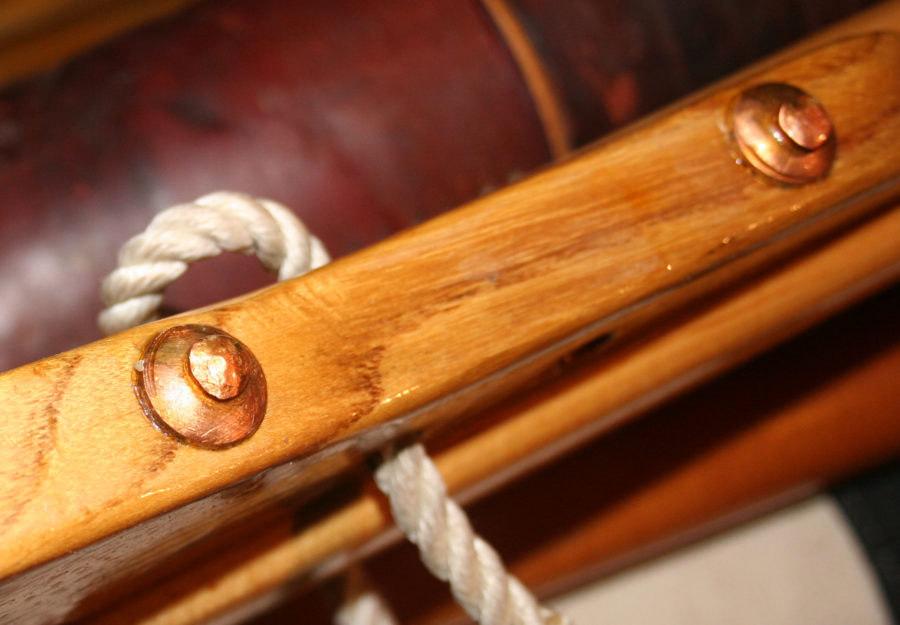
Homemade Rivets and Roves
I recently needed a handful of long rivets to secure the sides of a centerboard trunk to its ledges and to fasten jaws to a boom. Even if I could…
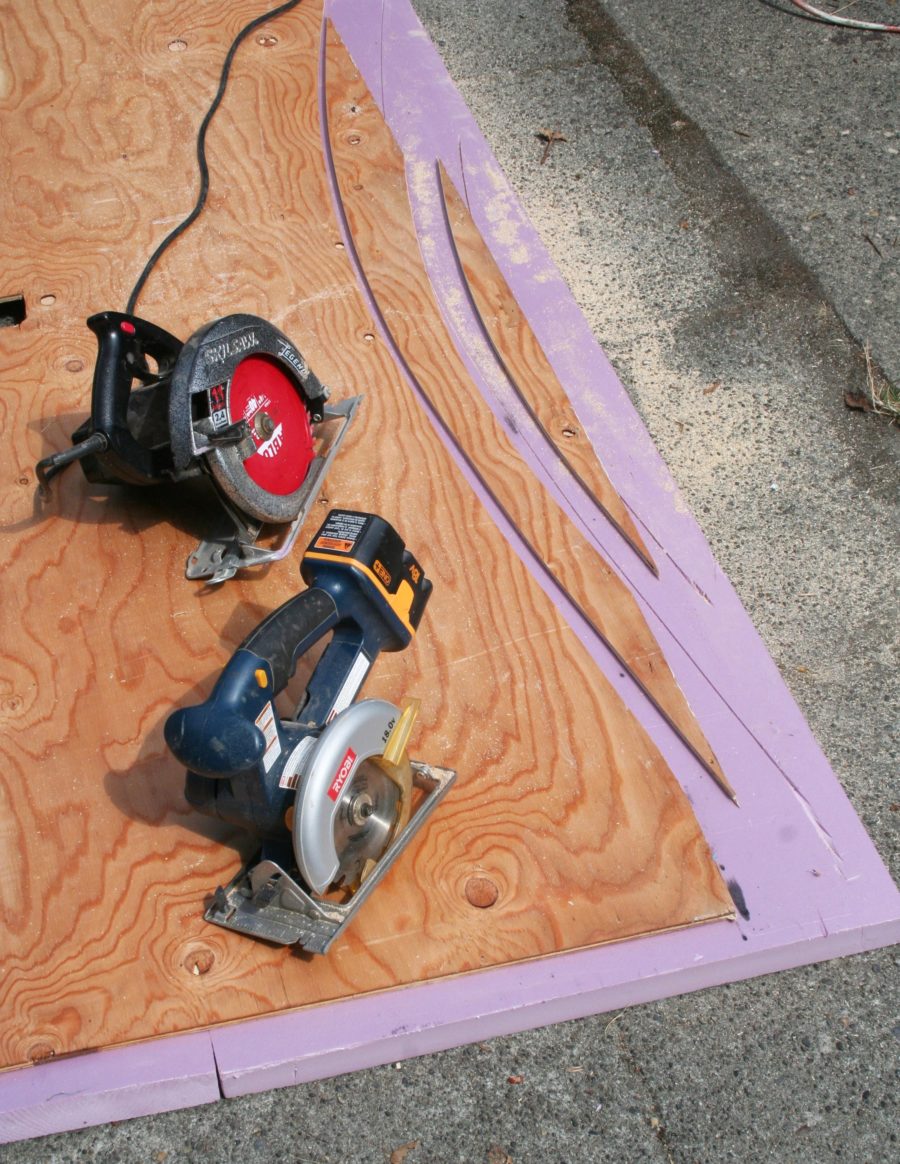
The Taming of the Sheet
Most of us who build boats at home do not have the facilities needed to handle 4′ x 8′ sheets of marine plywood with ease. I’ve always found it challenging…
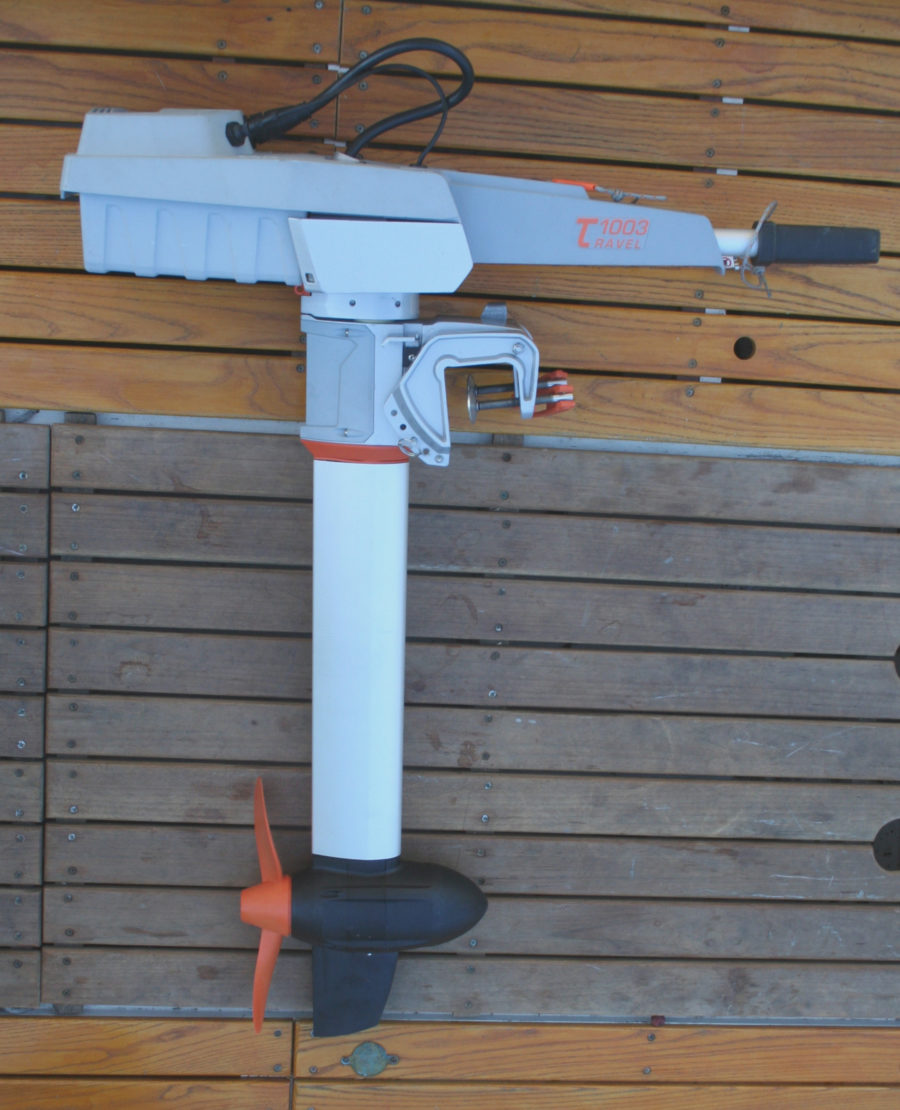
For decades I resisted boating under power and took pride in getting where I wanted to go under my own steam or under sail. That changed when I had kids:…
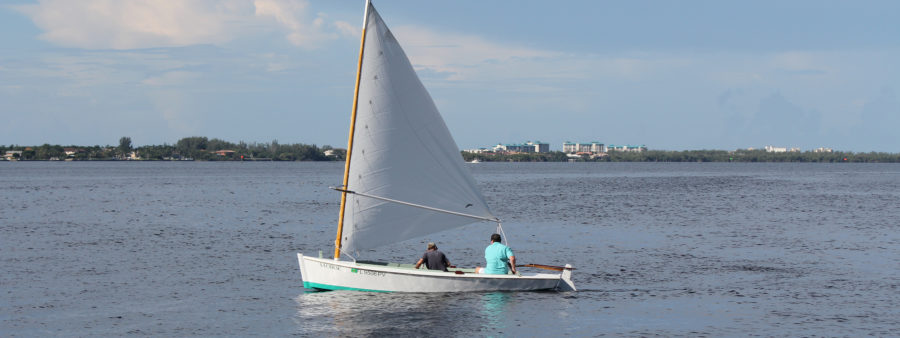
Reader Built Boats
Kevin Moroney grew up in South Salem, New York, not quite 10 miles south-southwest of Danbury, Connecticut; his home was near Truesdale Lake, a finger of water just shy of…
More Product Reviews
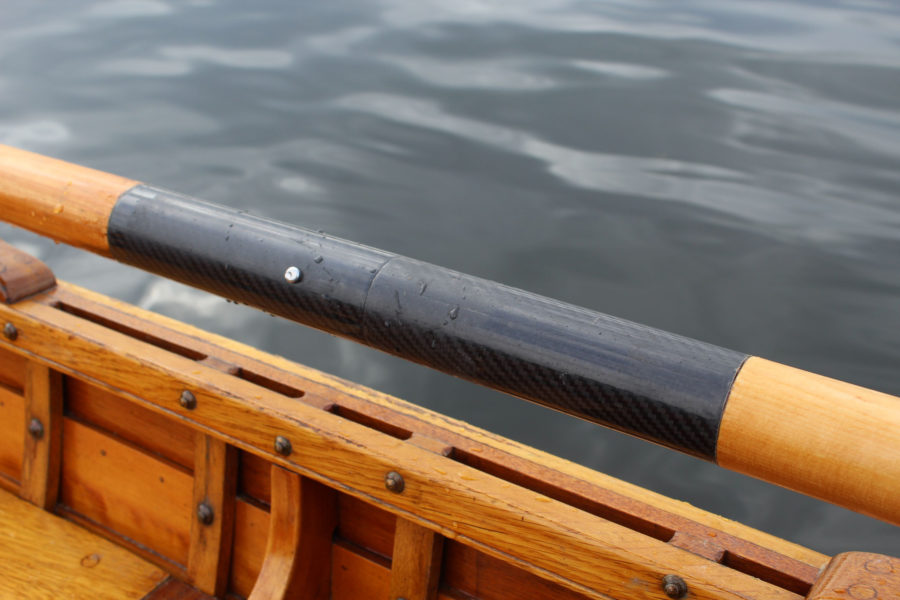
Carbon-Fiber Ferrules for Oars
Most of my boats are outfitted for rowing, and while I always have a pair of oars aboard, they’re often in the way when I’m sailing, motoring, or at anchor.…
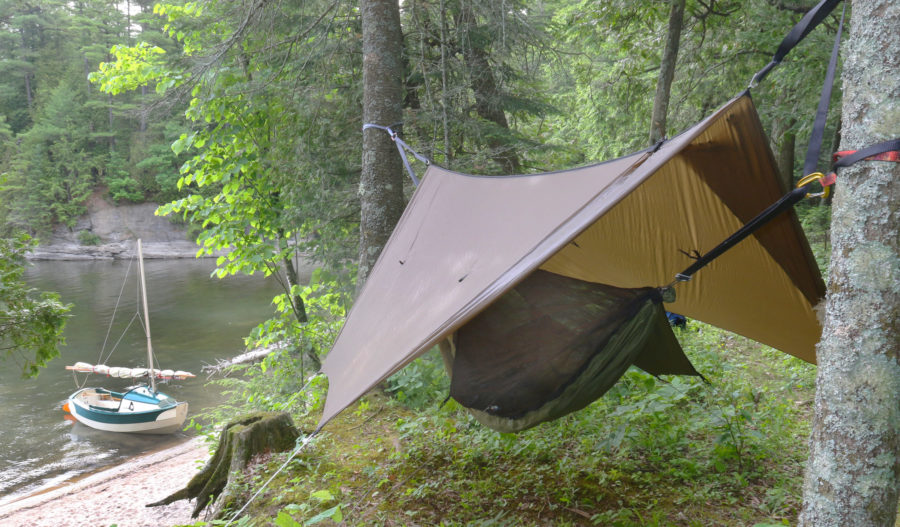
Blackbird XLC and Thunderfly
To preserve beautiful wild places for the future, visiting the wilderness requires camping with minimal impact. The Blackbird XLC camp hammock by Warbonnet, a Colorado based family-owned business, is a…
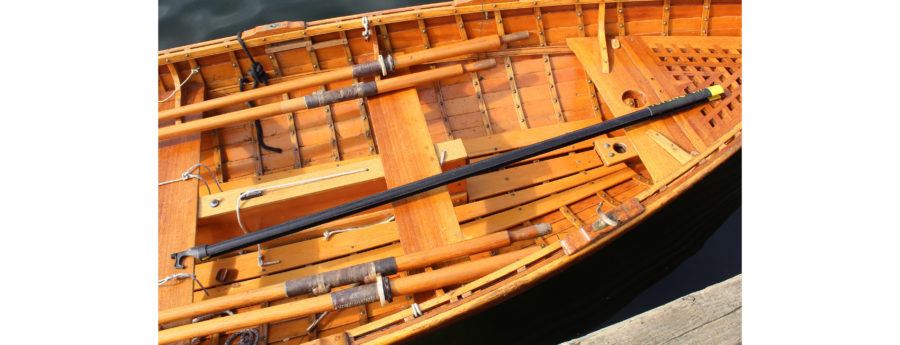
Revolve Boat Hook
While I’ve never carried a boathook aboard any of my boats, it’s not because I wouldn’t find one useful. Where space is limited, boathooks—even telescoping ones—are awkward to stow, so…
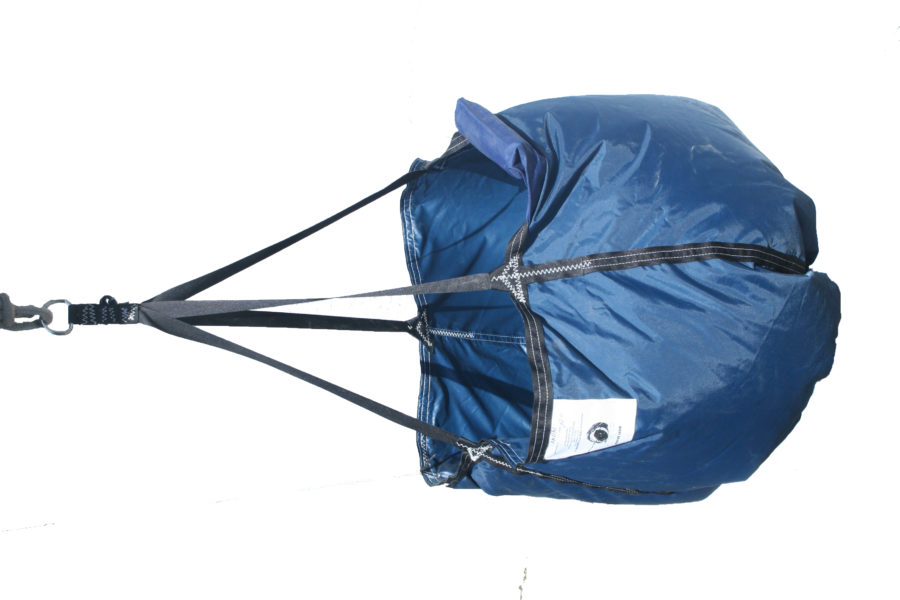
Paratech’s 24″ Boat Brakes
Sometimes it’s nice to be able to drift. But just drifting means your boat usually ends up broadside to the waves and slipping downwind. If you want to hold a…
Subscribe Today!
Become a subscriber today and you’ll recieve a new issue every month plus unlimited access to our full archive of backlogged issues.
Already a subscriber? Sign In
Subscribe For Full Access
Flipbooks are available to paid subscribers only. Subscribe now or log in for access.
- BOAT OF THE YEAR
- Newsletters
- Sailboat Reviews
- Boating Safety
- Sailing Totem
- Charter Resources
- Destinations
- Galley Recipes
- Living Aboard
- Sails and Rigging
- Maintenance

Torqeedo Travel 1003 Electric Outboard: Banishing the Fumes
- By Webb Chiles
- Updated: January 8, 2013
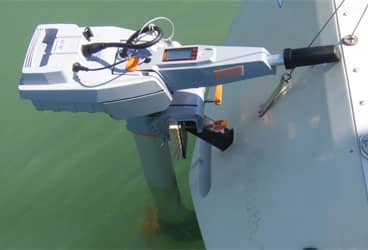
Torqeedo Travel 1003
The joy of sailing. A finely balanced hull cutting through waves. Blue sky above. Salt spray sparkling across the bow. Warm breeze against skin. A delightful whiff of gasoline. Wait! Stop! And I did, upon noting the first sniff of gasoline that I’ve detected on any boat that I’ve owned, over a span of almost 40 years.
Gannet , the Moore 24 I bought in 2011, came with not one but two gasoline outboards. I thought I’d keep whichever was more reliable—until that first whiff. Moore 24s have open interiors with limited places to stow outboards and jerry jugs of gasoline below, and I keep my decks uncluttered. On a passage, I’d inevitably find myself sleeping next to the outboard and gasoline and oil. It wasn’t going to happen.
Although before I made my first circumnavigation in her, I sailed the engineless, 37-foot Egregious in and out of her slip in San Diego, having no engine on Gannet was not an option. Her then home, North Point Marina on Lake Michigan, near the Illinois/Wisconsin border, with 1,500 slips the biggest freshwater marina in the world, doesn’t permit “sailing, rowing, paddling, or sculling” inside the breakwater. Neither do many other marinas. You may have noticed that the world is falling apart. Perhaps that’s happening because it’s being run by powerboaters.
After some research, I ordered a German-made electric Torqeedo Travel 1003—and learned that it isn’t easy being green. Why? First, in this case, is cost, and second is range.
A Travel 1003 costs roughly $2,000, more than twice the price of a gas outboard of similar power, and has a range of 2 to 16 miles. The 2 miles is at full throttle, when the 520-watt-hour battery will be discharged in 30 minutes. The 16 miles is at low throttle, when the battery will last eight hours.
On the light and easily driven Gannet , I’ve found that at medium throttle, which provides a speed of 2.5 knots, the battery is good for about three hours and a distance of 7 miles. In practice, this means that in and out of the harbor twice leaves the battery close to needing to be recharged, a task that takes more than 23 hours. Even with a boat that sails well, this short range presents problems.
When coastal cruising, I want to be at the next harbor before dark, and I like to start early. Powering across smooth water at first light before the wind comes up has its charms. With the quiet but not completely silent Torqeedo—there’s a not unpleasant whirring sound—those charms aren’t much compromised. But not many miles are covered, either.
Torqeedo offers a possible solution: a solar panel that rolls up for storage and is said to provide unlimited range in bright sunlight. This panel costs $1,000. Nevertheless, I requested and received one for my 70th birthday. Being old has its compensations.
I knew the dimensions of the panel, but sometimes you have to see something to really understand. When the box arrived, I thought it big. When I opened it and unrolled the panel, Carol, my wife, immediately said, “There’s no place for that on Gannet .” And within the length of its connecting cord, there wasn’t. I sent the panel back.

I’m considering buying a second battery, for $700, that would more than double my range by allowing one battery to be used while the other is being partially recharged by the boat’s main electrical system with its own solar panels. This would also increase the cost of being green to about three times that of an equivalent 3-horsepower gas outboard.
Having said all this, I don’t regret my choice at all.
The good news begins just after I place the clever Moore 24 outboard bracket in its slot in the stern. The bracket is easy to insert and remove even while the boat is under way, and so is the three-part Torqeedo, which, at 31 pounds for the long-shaft version, weighs about the same as a comparable gas outboard. On the advice of a former Moore 24 owner, I bought the long-shaft version. He meant well, but this was a mistake. The short shaft would’ve worked, saved a pound, taken up less room below, and not required special manipulation to clear the water when the engine isn’t in use.
On our first venture into Lake Michigan with the Torqeedo, I found that even when the engine was locked in the raised position, the long shaft left the prop partially dragging in the water, undercutting sailing performance and creating far more noise than the engine does in use. The solution—to tilt the engine more and secure it with sail ties to the stern-pulpit stanchions—means that I have to remove the tiller arm and stow it below. Slightly awkward, but necessary.
With the shaft tightened to the outboard bracket by two plastic-handled bolts, the battery is slipped into its slot, lowered, then locked by inserting a plastic pin. Finally, the tiller arm is attached and two electric cables connected: one from the battery to the shaft, the other from the tiller arm to the battery.
I’m struck by three things in this process: how well the Torqeedo is engineered and designed, how easy it is to mount and assemble, and how clean the parts are. No grease. No oil. No scrubbing my hands before I touch anything else.
My only reservation about the quality of the Travel 1003 is that the electrical cable connectors are plastic rather than metal and raise a concern about eventual cross threading. Thus far, I haven’t had a problem, but I do think metal connectors would be better and more appropriate on what is a top-end product.
With the Travel 1003 assembled comes a great moment: instant, one-finger starting. Press a button on the tiller arm and the Torqeedo is on, although the only way you know that is by the tiller-arm display lighting up. No repeated pulling on a cord. No curses. No fiddling. Not even a sound. In fact, there’s wonder and doubt that the engine is on, relieved by twisting the tiller handle and seeing the big, two-bladed prop turn. Back to neutral and absolute silence.
The Travel 1003 has forward, reverse, and, for 2,050-pound Gannet , ample power and torque. I don’t know how fast it will drive the little boat, but I’ve had her at 6 knots in one brief burst.
I knew my speed from the remarkable tiller-arm display, with built-in GPS, that shows the percentage of remaining battery charge, remaining range at the current speed, speed over ground, and consumption in watts. Increasing rpm and observing the often-dramatic decrease in range is instructive. An alarm sounds when battery charge drops to 30 percent.
I’ve only approached setting off that alarm once, when haze and a wind shift caused me to come in a mile downwind of the breakwater entrance. Unfortunately, I lowered sails before I realized my mistake. Gannet dislikes being powered into chop, and I had to keep increasing rpm to make any headway. Lesson learned, I’ve subsequently been more careful on my returns to the marina, and I’ve added jib-furling gear so I can resume sailing without having to haul a jib back on deck.
Engines are necessary because people have made them necessary.
I don’t take exception to North Point Marina’s rules. More than 1,500 boats trying, on a busy weekend, to use one narrow, partially silted over entrance, with some of them short-tacking under sail in front of confused powerboaters, is certain chaos and probable disaster.
Harbors all over are now laid out with the expectation that vessels have engines. To clear in with officials in many ports requires tying to docks impossible to reach under sail. So an engine or a tow is needed for the last few hundred yards. And I need an engine for the .75-mile trip from my slip to beyond the maelstrom of powerboat wakes at the breakwater entrance.
For those distances, and for me, the Torqeedo Travel 1003 is excellent.
Webb Chiles has moved Gannet to San Diego to prepare her for his next voyage. Kindle editions of his books are available from Amazon.com .
To read another family’s account of using the Torqeedo, click here .
- More: apparel , Electronics , Gear , Green Wakes , hardware , propulsion , torqeedo

C-Map Updates North America Charts

Setting Course for a More Sustainable Future
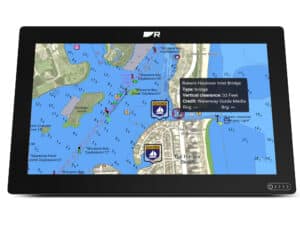
Raymarine Expands LightHouse Charts
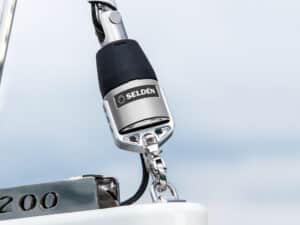
Push-Button Convenience
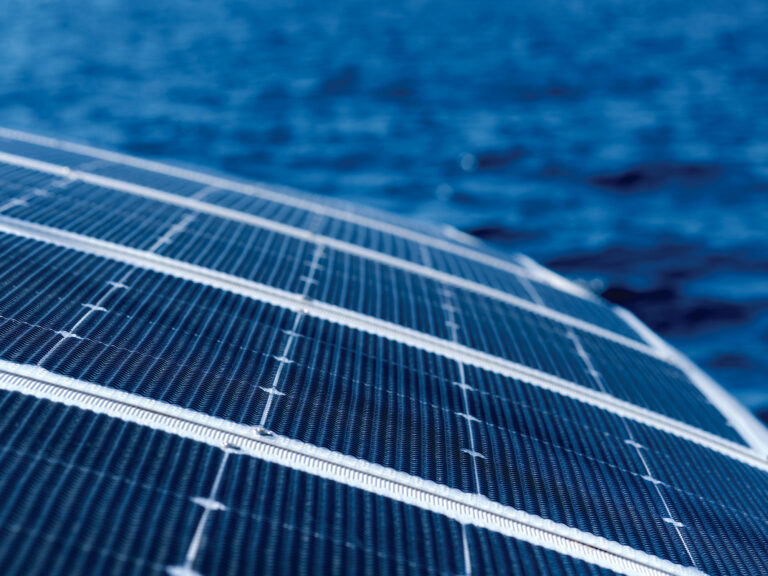
Charting a New Course
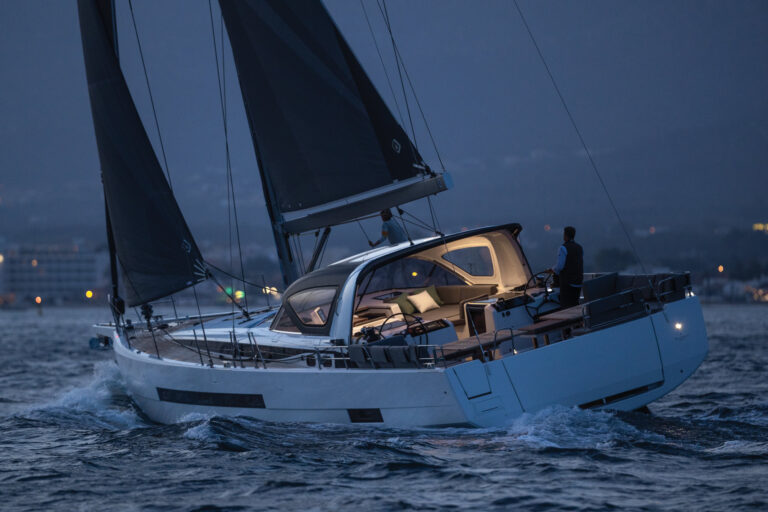
Sailboat Review: Jeanneau Yachts 55
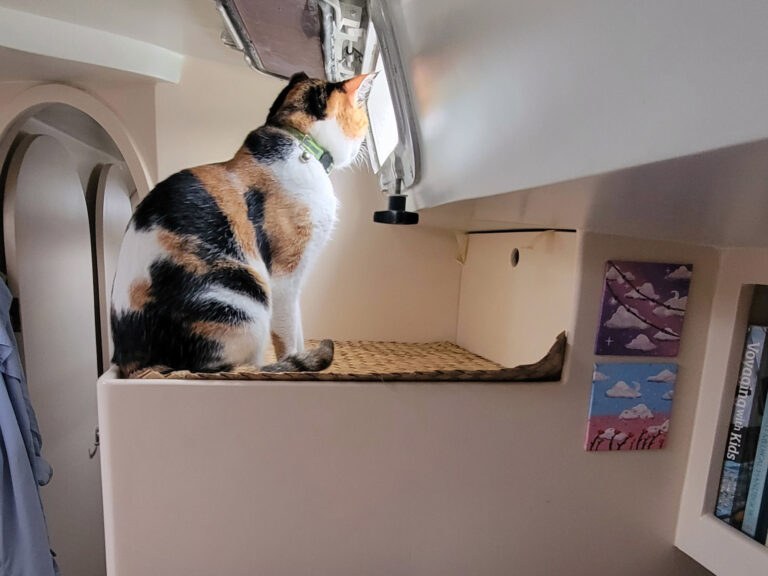
Cruising with a Pet
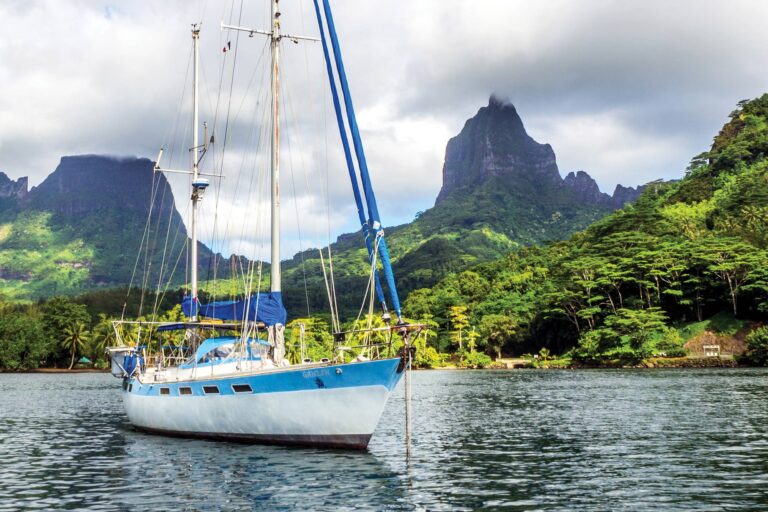
Fatty Goodlander: Have Little, Want Less
- Digital Edition
- Customer Service
- Privacy Policy
- Email Newsletters
- Cruising World
- Sailing World
- Salt Water Sportsman
- Sport Fishing
- Wakeboarding

The Marine Electronics Hub

- Electrical & Engines / Good Gear (non electronic)
Long tests: Interlux Pacifica Plus and Torqeedo Travel 1003
by Ben Ellison · December 4, 2013
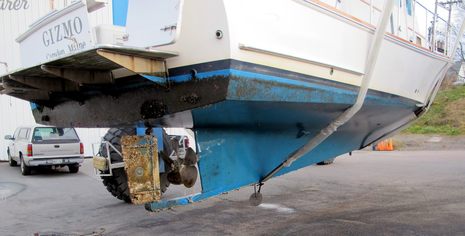
Gizmo’s port side, which gets more sun at her Camden home float, did have more slimy weed on it, but I don’t think it hurts the boat’s performance much. I don’t like how the slime looks, but I could have scrubbed it off easily as the ablative paint was still very soft. That’s a finger swipe near the aft waterline in the photo below, and you can see how the pressure hose is sending blue paint into Wayfarer Marine’s catch basin (it’s a certified “Clean Marina” ). Of course, if I’d done more scrubbing, I might have stripped off all the active paint — a rationale for sloth? — but overall it seems like I got a whole lot of value from two gallons of Pacifica Plus that cost about $400 . It also seemed good not to ablate cuprous oxide into the water (and boatyard workers), though I realize that the jury is still out on the environmental and health effects of the paint’s Biolux and Econea biocides.
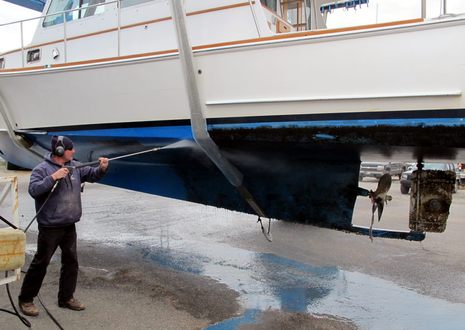
Related Posts:
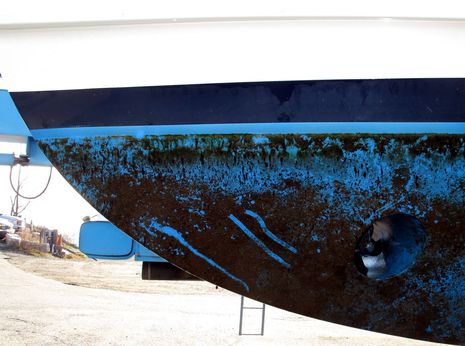
Ben Ellison
Panbo editor, publisher & chief bottlewasher from 4/2005 until 8/2018, and now pleased to have Ben Stein as a very able publisher, webmaster, and editing colleague. Please don't regard him as an "expert"; he's getting quite old and thinks that "fadiddling fumble-putz" is a more accurate description.
16 Responses
- Comments 16
- Pingbacks 0
PS Torqeedo’s magnetic “ignition key” doesn’t stand up to a lot of sun, as seen in the next to last photo, but I learned that any strong magnet works.
PPS If you click on the top photo to make it big, you will see what a poor idea it was to use ablative anti-fouling paint on a stainless rudder that’s regularly in the wash of a 28×28 five-bladed prop driven by a 450hp engine. I probably should have used the same Pettit Zinc Barnacle Barrier that did pretty well over 18 months on the prop itself: http://www.pettitpaint.com/product.asp?id=262 but I’m interested in alternatives for both… Also, no blame to the Interlux Pacifica Plus for all those barnacles under the keel. I know the exact location of the bump in the southern New Jersey Intracoastal Waterway where I left that paint 😉
We’ve learned to live with our Travel 1003. Essentially, treat the throttle as if it is a nuclear bomb: very gingerly. You can engage it, but slowly. You can floor it, but very progressively. You can reverse it, but gradually. Anything else, and be ready to face the E-demons: the thing locks up and must be rebooted. I’ve looked into getting a Li-Ion or similar small/lightweight 12V batt to provide up to 50 watts of power/recharge _during_ use of the 1003, like some Aussies do, but at circa $350 when it is all said and done, am rather considering just biting the bullet and getting a second Torqeedo-brand battery for $700. In addition to the Travel 1003, we have a brand new Tohatsu in the lazarette since almost a year ago. We’ve never used it yet. Ethanol, oil, weight, refueling, who has time for that? Eventually we’ll need its power or range, and that’s why it’s there, but I dread the day. So the electric is just an easier package, but it is heavy on the wallet and requires deliberation when in use.
Where did you moor in fresh water in South Carolina?
Ben, What paint did you use on the rudder? With the bottom looking so good the rudder has a lot of growth. I wonder if the rudder sees more turbulence and allows the ablative paint to bleed off more quickly then the paint on the bottom. The prop on Gizmo looks fine. I used the same Pettit #1792 from a spray can and experienced the same performance, which is very acceptable in my opinion. I think the only alternative worth a try, at great cost, is PropSpeed, http://www.propspeedusa.com . Some people in the boat yard love it and some did not have success with it. I’m told the application of PropSpeed is very tricky and may be the reason for some failures.
Orin, my boat spend last winter (Nov. thru March) at Osprey Marina near Myrtle Beach, SC. If you look on the Transient page here, you’ll see that they describe themselves a freshwater marina and the location is a man-made basin near the upper reaches of the Waccamaw River (which is used as the ICW): http://www.ospreymarina.com/ It’s a bit mysterious as there are tides at the marina, and I didn’t taste test or swim in the water (it’s very brown) but I did observe the fairly rapid death and disappearance of waterline weed that looked something like the photos at top when I arrived. Then a new kind of slime grew on the boat (which also got covered with incredibly sticky yellow pine pollen). The freshwater fouling died when I got in salty water again; in fact, the bottom paint looked really good by the time I got back to Camden in early May. (But I still sometimes find clots of the pollen stuck to things.) All in all, the salinity change was a neat bonus on top of what is already a well managed, super safe, and reasonably priced marina. It may also account for the fact that all my Zincs survived the 18 months, though some were close. Incidentally, the heavy mussel growth seen on the underwater lights and aft zinc must have happened this fall; otherwise I would have stiff brushed it off. Richard, I tried Pacifica Plus on the rudder in May 2012 because I didn’t have enough zinc spray. I think it’s fine to use on any metal (because it contains no metal) but it obviously couldn’t handle the prop wash.
We had horrible success with Pacifica on a sailboat in MD. In fact, oysters grew all over it like it was a most wonderful host. The paint came from Interlux as a gift because the previous coating of Micron 66 had “cornflaked” in low salinity water of that weather freaky year, 2010 ?, where a lot of rain had fallen on NY and VT and then watershed’d its way down and into the Chesapeake. I wondered if the paint gifted had been from a previous formula because on another boat and one painted more recently, the results are better. With the oyster’d boat, we were told that the boat “needed more use”. That’s a great command but sometimes not practical. Never-mind, the failure prompted a move to Petitt and to their heaviest copper offering, a paint that PS recommends. The proof is that it was clean/clean at this week’s haulout. This same customer bought a Torqueedo at the Boat Show year before last and loves it so much .. it’s kept under lock, key and glass cover. I’ve used it once, and have to row out to the mooring !
I’d love to see a long term test of an ultrasonic anti-fouling system like this one: http://www.westcoastultrasonics.com . I’ve been pondering this option every time I haulout my boat and have to paint.
Adam, my friend Charlie Doane has been testing ultrasonic anti-fouling on his aluminum sloop Lunacy for about three years. I think this is latest post on Wavetrain: http://www.wavetrain.net/the-lunacy-report/411-ultrasonic-antifouling-second-full-season-results Charlie has also tried several copper-free paints (none of which made him happy) during this same period. Plus he’s using the single frequency UltraSonic brand while you referenced the Soanar brand which works at multiple frequencies. Also, PYI has just started distributing the Sonihull multi-frequency anti-fouling system: http://www.pyiinc.com/sonihull/sonihullduo.html
Neat that eMarine has a small solar panel for charging Torqeedo batteries and also a 12v charging cord, both reasonably priced, I think: http://goo.gl/ktA78l
Looks like a reasonable item, surely a desirable thing. I will say that $26 is a bit steep for the 2.5 mm plug. When I wired one to the 12 v panel on my boat, I think a pair of the 2.5 plugs cost about $3. That’s retail, in a radio shack in Maine. Sure, the cable is one piece and more water resistant, but really, I don’t think that I’d consider leaving the battery unit exposed to water when charging. Ever. The panels are quite nice.
Ben: I’ve been using a Torqeedo Travel 1003 since 2013 on my 27 foot sloop (2400 lbs.). Very easily driven hull, and I can get about 6 miles if I go easy on the throttle. I only use the motor when it’s flat calm, otherwise I sail. Thus I had to have a 2nd battery to have some reserve when cruising, and I had to find a place to plug in overnight once in a while.
Two years ago I decided to go solar, but the Torqeedo solar panel was very expensive and much too big for my boat. You need 50 watts to charge their 24 volt battery directly. But then I saw that you could get a cable from them to charge from a 12 volt marine battery. And I could get a 40 watt solar panel, that was small enough for my aft deck and much cheaper, and would charge the 12V battery. Now I keep one Torqeedo battery plugged into the 12V battery in the laz, which is being trickle charged constantly by the solar panel. When the motor battery gets low I swap them, and since the 12V battery is constantly full it will charge the spare battery to about 80% in just a couple of hours. This allows me to motor for most of a day if I should need it.
It all fits in my small lazarette, and worked flawlessly for my 6-month season last summer.
Thanks, Andy, this is good info that may be useful to some Torqeedo outboard owners, including me.
But aren’t you also the guy who learned that a 1003 is buoyant enough that if you drop one off the stern in a bit of a tidal current, it may wander off to parts unknown? 😉
Andy replied via email:
***************************************
Yup. It sank, but then wandered off. It’ll probably turn up in Camden.
But that was only half of it. After replacing it (with a used one), last spring when Bob V. launched her he turned too sharp pulling her out of the TravelLift and broke that one off. He had a diver fetch it the next morning and when they opened it up (a week later) there was salt water and corrosion inside. Now that was an older motor, but I had just (a month earlier) had it factory serviced and re-sealed, and they saw no evidence of any corrosion then. So Bob had to buy me a new pylon. He was pretty grumpy about it, but he did it.
Moral of that story…when they say it’s waterproof to IP67 (1 meter for 30 min.), they mean it. (And I do have a leash on it finally…and it’s less than one meter long.)
I have several reservations about these motors, but I’ve got it, and it means I don’t have any oil or gas on board, very little noise, I can lift it with one hand, and it runs reliably. I think my first battery (2013) will probably give out in a year or two, so that means it costs me about $100/year, although the motor was expensive.
My reservations they claim are getting fixed in a new model coming soon. The Tilt-Lock mechanism breaks in less than one season. The plastic threads on both the tiller connection and the power connection cross-thread and strip very easily, and the lock-down lever (for reverse) requires you to be an acrobat if you’re not in a dinghy.
The US big guy for the company did respond to my complaints on these items and claims they are working on it.
The new Travel 1103 C is out with some of those improvements plus more power and even less noise:
https://www.torqeedo.com/us/en-us/products/outboards/travel/travel-1103-c/M-1151-00.html
I’ll get to try this and lots of other Torqeedo gear in Germany early next month, and will report back.
Tiller handle Torqeedo 1003 shutting motor down sending error message 23. I solved this problem by taking tiller handle apart drying out electrical circuit board and spraying w40 on the 3 contacts buttons. setup,cal, and start. Rust had formed on buttons after water had gotten in through clear plastic multifunctional display.
Join the conversation Cancel reply
Your email address will not be published. Required fields are marked *
Save my name, email, and website in this browser for the next time I comment.
Don't subscribe All new comments Replies to my comments Notify me of followup comments via e-mail. You can also subscribe without commenting.
Editors' Blog

David Burch wants to educate us about Electronic Navigation Charts (ENC)

Panbo(at) gets more stable: Seakeeper 1 install in progress


Epoch’s new 460 amp-hour, external communicating battery arrives and testing begins

METS 2023: EPT Technologies solid-state battery destruction demo

Gizmo’s new (though previously owned) compass, thanks to Max Marine Electronics
Join our list and be notified of new posts, subscribe to panbo.
Subscribe to Panbo to be notified of new posts and content
Press Releases

Recent Panbo Comments
Recent forum posts.
Interface HVAC with MFD
We are working on an electronics refit and in the proce...
By Trey Weitzel , 1 month ago
B & G Net Work Pilot auto pilot compass not working
Our B&G auto pilot compass is not working. It was w...
By Todd Young , 1 month ago
RE: Epoch 460 battery
What does “awaiting moderation” mean? Did I break a rul...
By Jim Duke , 2 months ago
I made a previous request to Ben which may have gotten ...
I think this is a fine place for it and comes with the ...
By Ben Stein , 2 months ago
Epoch 460 battery
Ben, The comments on your Epoch 460 article is gettin...

Torqeedo Travel 1003 C
Torqeedo Travel 1003 C The Travel 1003 C is a new and uprated version of Torqeedo’s award-winning Travel 1003. This new electric outboard takes the concept of clean silent propulsion further, by offering extended range and runtime. Surprisingly it does not do this at the cost of extra bulk and weight, and like the 1003 it comes with an integrated lithium battery. Recent advances in lithium battery technology have enabled Torqeedo to produce a 915Wh battery, with a 73% increase in battery capacity compared to the battery on the standard Travel 1003, and with an almost identical weight. Both Torqeedo 1003 models offer the same wide-open throttle performance as a 3hp petrol outboard motor. However, due to the fact that electric engines produce maximum torque from zero to maximum RPM, the 1003 has the thrust equivalent of a 4hp motor across its mid-range power delivery. Running the 1003 at its mid-range sweet spot makes good sense, as at full power any electric motor quickly digests its battery’s reserves, compared to running at 75% of its maximum output. The Travel range is designed for tenders, dinghies and dayboats up to 1.5 tons, for which it has already proven very successful. With a total weight of just 14.9kg, including the integrated lithium battery, Torqeedo claim that the Travel 1003 C is the lightest and most efficient electric outboard in its class on the market. As standard, the Travel 1003 C comes with a GPS system, a digital read-out that displays power consumption, battery status and remaining range (displayed in either time or distance), and a convenient USB socket for charging a phone or powering a light while out on the water. The battery, though mounted on the powerhead, is easily removed or changed for a spare should you need it. However, at £749 for a second 915Wh battery I imagine most people will consider this option carefully. Users can download Torqeedo’s innovative free TorqTrac smartphone application for use with the new Travel 1003 C. When combined with Torqeedo’s Bluetooth TorqTrac adaptor, the TorqTrac app displays all motor information on a smartphone or similar device, and allows you to plan your trip in advance and share your position on a map with an estimated time of arrival. It also has a navigation facility that allows you to create waypoints, enabling you to pick your way out to your mooring on the darkest of nights. Torqeedo also offer a range of innovative accessories for their entire range of motors, including handy travel bags for the engine and battery, as well as a foldable solar panel for convenient and environmentally friendly charging on the go. The 1003 C is tiller-steered, with a four-step trim setting, and is waterproof to IP67 standard. The new Travel 1003 C is available for the 2017 boating season in a standard and long-shaft version, and is priced from £1,699 (inc. VAT).
Contact www.torqeedo.com
Related Posts
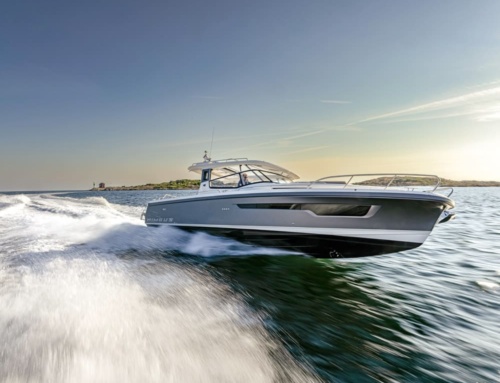
Ryds 735 VI

The Sea Ray 210 Shootout – Outboard Versus Sterndrive

Capoforte SQ240

Overview: Navier N30

Overview: Galeon 450 HTC

Subscribe to the PBR Newsletter
Get all the latest news, reviews and exclusives, direct to your inbox
By clicking subscribe, you agree to receive news, promotions and offers by email from PBR. Your information will be used in accordance with our privacy policy .
- Testberichte
- Einstellungen
- Sport & Gesundheit
- Wassersport
Bootsmotoren
- Torqeedo Bootsmotoren
- Torqeedo Travel 1003
Torqeedo Travel 1003 2 Tests
- Typ: Außenborder
- Antriebsart: Elektro
- Alle Produktdaten ›
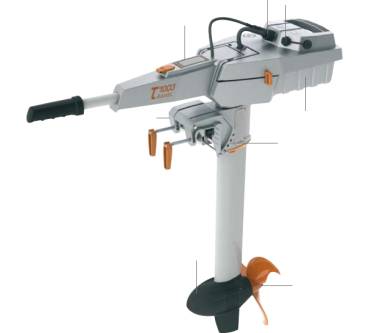
Befriedigend
Aktuelle Info wird geladen...
Torqeedo Travel 1003 im Test der Fachmagazine
- Erschienen: 17.03.2010 | Ausgabe: 4/2010
- Details zum Test
ohne Endnote
2 Produkte im Test
„... Auch der bisherige Travel 801 hat mit seinen 1.499 Euro bereits einen stolzen Preis, der vom Travel 1003 noch einmal mit 1.699 Euro getoppt wird. Dennoch sind die Vorzüge wie größerer Akku, der Bordcomputer und vor allem die Wasserdichtheit eine unschlagbare Entwicklung gegenüber dem Travel 801. ...“
- Erschienen: 27.05.2010 | Ausgabe: 6/2010
„... In der Leistung stehen Motore, wie der Torqeedo 1003 seinen Konkurrenten mit Benzin in nichts nach. Er kommt sogar dank hoher Effizienz mit weniger Energie aus und einen herrlichen weiteren Vorteil, er läuft mucksmäuschenstill. Der Preis für den Torqeedo1003 liegt bei 1.699 Euro.“
Ich möchte benachrichtigt werden bei neuen Tests zu Torqeedo Travel 1003
Kundenmeinungen (9) zu Torqeedo Travel 1003 siehe FAQ " aria-label="öffnet Tooltip Erklärung" >

Durchschnitt aus 9 Meinungen in 1 Quelle
9 Meinungen bei Amazon.de lesen
Bisher keine Bewertungen
Helfen Sie anderen bei der Kaufentscheidung.
Passende Bestenlisten: Bootsmotoren
Datenblatt zu torqeedo travel 1003.
Alle Preise verstehen sich inkl. gesetzlicher MwSt. Die Versandkosten hängen von der gewählten Versandart ab, es handelt sich um Mindestkosten. Die Angebotsinformationen basieren auf den Angaben des jeweiligen Shops und werden über automatisierte Prozesse aktualisiert. Eine Aktualisierung in Echtzeit findet nicht statt, so dass der Preis seit der letzten Aktualisierung gestiegen sein kann. Maßgeblich ist der tatsächliche Preis, den der Shop zum Zeitpunkt des Kaufs auf seiner Webseite anbietet.
Mehr Infos dazu in unseren FAQs
- Neutrale Ratgeber – hilfreich für Ihre Produktwahl
- Gut getestete Produkte – passend zur Jahreszeit
- Tipps & Tricks
- Torqeedo Manuals
- Outboard Motor
- Travel 1003 CL
Torqeedo Travel 1003 CL Manuals
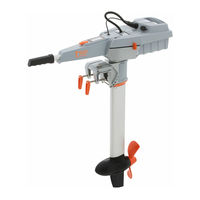
Torqeedo Travel 1003 CL Owner's Manual (30 pages)
Table of contents.
- Table of Contents 3
1 Important Safety and Operating Information
2 information required by law.
- Identification and Technical Data 6
- Conformity Declaration 8
3 Equipment and Operating Elements
- Delivery Scope 9
- Plan of Operating Elements 9
4 Starting up
5 operation.
- Normal Operation 12
- Multifunctional Display with Beep 12
- Tilting the Motor and Fixing the Steering 14
- Battery Safety Instructions 15
- General Information on Batteries 16
- Charging the Batteries from the Mains 17
- Charging the Batteries from the On-Board Batteries 18
- Charging the Batteries Using Solar Energy 19
- Power Supply to a Device Via USB Supply Connection 19
- Unusual Functions/Emergency Situations 20
- Error Messages/Trouble Shooting 21
6 Dismantling
7 storage and care instructions.
- Corrosion Protection, Care, Maintenance 23
- Caring for the Battery 23
- Changing the Propeller 24
8 Warranty Terms
- Extent of Warranty 25
- Warranty Process 26
9 Accessories
10 decommissioning the product / disposal.
- Disposing of Waste Electrical and Electronic Equipment 28
- Disposing of of Batteries 29
11 Torqeedo Service Centers
Advertisement
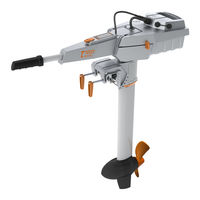
Torqeedo Travel 1003 CL Manual (32 pages)
- Table of Contents 2
- Normal Operation 13
- Battery Safety Instructions 16
- General Information on Batteries 17
- Charging the Batteries from the Mains 18
- Charging the Batteries from the On-Board Batteries 19
- Functions/Emergency Situations 21
- Error Messages/Trouble Shooting 22
- Protection, Care, Maintenance 25
- Disposing of Waste Electrical and Electronic Equipment 30
- Disposing of of Batteries 30
Related Products
- Torqeedo Travel 1003 L
- Torqeedo Travel 1003 S/L
- Torqeedo Travel 1003 S
- Torqeedo Travel 1003
- Torqeedo Travel 1003 CS
- Torqeedo Cruise 10.0R
- Torqeedo Travel 1103 CS
- Torqeedo Travel 1103 CL
- Torqeedo Ultralight 1103 AC
- Torqeedo Cruise 12.0 R TorqLink
Torqeedo Categories
Upload manual.
Claudia Looi
Touring the Top 10 Moscow Metro Stations
By Claudia Looi 2 Comments

Komsomolskaya metro station looks like a museum. It has vaulted ceilings and baroque decor.
Hidden underground, in the heart of Moscow, are historical and architectural treasures of Russia. These are Soviet-era creations – the metro stations of Moscow.
Our guide Maria introduced these elaborate metro stations as “the palaces for the people.” Built between 1937 and 1955, each station holds its own history and stories. Stalin had the idea of building beautiful underground spaces that the masses could enjoy. They would look like museums, art centers, concert halls, palaces and churches. Each would have a different theme. None would be alike.
The two-hour private tour was with a former Intourist tour guide named Maria. Maria lived in Moscow all her life and through the communist era of 60s to 90s. She has been a tour guide for more than 30 years. Being in her 60s, she moved rather quickly for her age. We traveled and crammed with Maria and other Muscovites on the metro to visit 10 different metro stations.

Arrow showing the direction of metro line 1 and 2

Moscow subways are very clean
To Maria, every street, metro and building told a story. I couldn’t keep up with her stories. I don’t remember most of what she said because I was just thrilled being in Moscow. Added to that, she spilled out so many Russian words and names, which to one who can’t read Cyrillic, sounded so foreign and could be easily forgotten.
The metro tour was the first part of our all day tour of Moscow with Maria. Here are the stations we visited:
1. Komsomolskaya Metro Station is the most beautiful of them all. Painted yellow and decorated with chandeliers, gold leaves and semi precious stones, the station looks like a stately museum. And possibly decorated like a palace. I saw Komsomolskaya first, before the rest of the stations upon arrival in Moscow by train from St. Petersburg.
2. Revolution Square Metro Station (Ploshchad Revolyutsii) has marble arches and 72 bronze sculptures designed by Alexey Dushkin. The marble arches are flanked by the bronze sculptures. If you look closely you will see passersby touching the bronze dog's nose. Legend has it that good luck comes to those who touch the dog's nose.

Touch the dog's nose for good luck. At the Revolution Square station

Revolution Square Metro Station
3. Arbatskaya Metro Station served as a shelter during the Soviet-era. It is one of the largest and the deepest metro stations in Moscow.

Arbatskaya Metro Station
4. Biblioteka Imeni Lenina Metro Station was built in 1935 and named after the Russian State Library. It is located near the library and has a big mosaic portrait of Lenin and yellow ceramic tiles on the track walls.

Lenin's portrait at the Biblioteka Imeni Lenina Metro Station

5. Kievskaya Metro Station was one of the first to be completed in Moscow. Named after the capital city of Ukraine by Kiev-born, Nikita Khruschev, Stalin's successor.

Kievskaya Metro Station
6. Novoslobodskaya Metro Station was built in 1952. It has 32 stained glass murals with brass borders.

Novoslobodskaya metro station
7. Kurskaya Metro Station was one of the first few to be built in Moscow in 1938. It has ceiling panels and artwork showing Soviet leadership, Soviet lifestyle and political power. It has a dome with patriotic slogans decorated with red stars representing the Soviet's World War II Hall of Fame. Kurskaya Metro Station is a must-visit station in Moscow.

Ceiling panel and artworks at Kurskaya Metro Station

8. Mayakovskaya Metro Station built in 1938. It was named after Russian poet Vladmir Mayakovsky. This is one of the most beautiful metro stations in the world with 34 mosaics painted by Alexander Deyneka.

Mayakovskaya station

One of the over 30 ceiling mosaics in Mayakovskaya metro station
9. Belorusskaya Metro Station is named after the people of Belarus. In the picture below, there are statues of 3 members of the Partisan Resistance in Belarus during World War II. The statues were sculpted by Sergei Orlov, S. Rabinovich and I. Slonim.

10. Teatralnaya Metro Station (Theatre Metro Station) is located near the Bolshoi Theatre.

Teatralnaya Metro Station decorated with porcelain figures .

Taking the metro's escalator at the end of the tour with Maria the tour guide.
Have you visited the Moscow Metro? Leave your comment below.
January 15, 2017 at 8:17 am
An excellent read! Thanks for much for sharing the Russian metro system with us. We're heading to Moscow in April and exploring the metro stations were on our list and after reading your post, I'm even more excited to go visit them. Thanks again 🙂
December 6, 2017 at 10:45 pm
Hi, do you remember which tour company you contacted for this tour?
Leave a Reply Cancel reply
You must be logged in to post a comment.
Please go to the Instagram Feed settings page to create a feed.
- History of cooperation
- Areas of cooperation
- Procurement policy
- Useful links
- Becoming a supplier
- Procurement
- Rosatom newsletter
© 2008–2024Valtiollinen Rosatom-ydinvoimakonserni

- Rosatom Global presence
- Rosatom in region
- For suppliers
- Preventing corruption
- Press centre
Rosatom Starts Life Tests of Third-Generation VVER-440 Nuclear Fuel
- 16 June, 2020 / 13:00
This site uses cookies. By continuing your navigation, you accept the use of cookies. For more information, or to manage or to change the cookies parameters on your computer, read our Cookies Policy. Learn more
- ‹ Return |
- › Products
- › Travel 1003
- › Operating Instructions
JavaScript functionality for your browser has been deactivate. Please activate JavaScript so you can use all functions on this page.
Travel 1003 Operating Instructions
Travel 401/801 operating instructions, basetravel 401/801 operating instructions.

IMAGES
VIDEO
COMMENTS
Torqeedo lists the shaft length for the Travel 1003S at 62.5 cm (24 5/8″), a measurement from the bearing surface of the mounting bracket to the center of the prop. On gas outboards the shaft length is commonly measured to the anti-ventilation plate, not the propeller axis; the Travel 1003 has no anti-ventilation plate, but I measured 46.5 cm ...
Join Tim van Duyl as he reviews how the Torqeedo Travel 1003 performs, capable of pushing RIBS and small boats, it is truly electrifying out on the water.Tra...
A Travel 1003 costs roughly $2,000, more than twice the price of a gas outboard of similar power, and has a range of 2 to 16 miles. The 2 miles is at full throttle, when the 520-watt-hour battery will be discharged in 30 minutes. The 16 miles is at low throttle, when the battery will last eight hours. On the light and easily driven Gannet, I ...
The Travel 1003 C offers almost three times the battery capacity of the Travel 503, which is why it has a significantly greater range. Both motors are suitable for inflatables and other small boats. The Travel 1003 will also easily propel tenders, dinghies and sailboats up to 1.5 tons.
Please find out the Torqeedo 1003's performances registered during out test day. Torqeedo 1003 - Performances. The following data were collected on August 18th in Santa Giulia, Corsica. ... Travel 1003 Travel 1003 C; Input power in watts: 1000: 1000: Propulsive power in watts ... (CL) Motor weight without battery in kg: 8.9(S) / 9.5(L) 8.9 ...
By Guy Venables It is particularly satisfying to test a product which solves previous problems. The Torqeedo Travel 1003 is an electric outboard that doesn't rely on a heavy acidic car battery. Instead, there's an integrated and sealed clip-on rechargeable lithium battery that makes
Travel 1003; Input power in watts: 1000: Propulsive power in watts: 480: Comparable petrol outboards (propulsive power) 3 HP: ... To compare Torqeedo static thrust data with conventional trolling motors, add approximately 50% to the Torqeedo static thrust values. Technical Drawing . Travel 1003L Travel 1003S . This website uses cookies. By ...
The long test of the Torqeedo Travel 1003 electric outboard also started in May 2011 and has gone equally as well in my view, ... Ben: I've been using a Torqeedo Travel 1003 since 2013 on my 27 foot sloop (2400 lbs.). Very easily driven hull, and I can get about 6 miles if I go easy on the throttle. ...
The Travel 1003 C is a new and uprated version of Torqeedo's award-winning Travel 1003. This new electric outboard takes the concept of clean silent propulsion further, by offering extended range and runtime. Surprisingly it does not do this at the cost of extra bulk and weight, and like the 1003 it comes with an integrated lithium battery.
tested turner PMY electric torqeedo gear outboard Power & Motoryacht done great gear test. Torqeedo. When it comes to testing engines, Capt. Bill Pike has walked the walk. From pods to Liquefied-Nitrogen Gas powered boats, you name it he's reviewed it. Now see what he has to say about his first electric outboard test.
In der Leistung stehen Motore, wie der Torqeedo 1003 seinen Konkurrenten mit Benzin in nichts nach. Er kommt sogar dank hoher Effizienz mit weniger Energie aus und einen herrlichen weiteren Vorteil, er läuft mucksmäuschenstill. Der Preis für den Torqeedo1003 liegt bei 1.699 Euro.".
My experience buying and using a Torqeedo Travel 1003. Problems I had, and conditions it is used in
View and Download Torqeedo Travel Series owner's manual online. Travel Series outboard motor pdf manual download. Also for: Travel 503 s, Travel 1003 cl, Travel 1003 cs, Travel 1003 s, Travel 1003 l.
We have 2 Torqeedo Travel 1003 CL manuals available for free PDF download: Manual, Owner's Manual . Torqeedo Travel 1003 CL Owner's Manual (30 pages) Brand: Torqeedo | Category: Outboard Motor | Size: 1.45 MB Table of Contents. 3. Table of Contents. 4. 1 Important Safety and Operating Information ...
The Torqeedo Travel's on-board computer calculates the remaining range constantly, by linking the motor's consumption data with the charging level of the batteries, and the speed over the ground from the GPS. This allows you to read the remaining range in real time from the motor display or the smartphone app TorqTrac. This website uses cookies.
The Adventure Package gets kayak anglers quickly and stealthily to their secret spots. Once you choose, it's time to explore your charging, propeller, and accessory options to build your perfect electric Travel companion. The Essential Package is the original Travel, redefined, and the Range Package features a higher-capacity battery for when you want to spend all day on the water.
Revolution Square Metro Station. 3. Arbatskaya Metro Station served as a shelter during the Soviet-era. It is one of the largest and the deepest metro stations in Moscow. Arbatskaya Metro Station. 4. Biblioteka Imeni Lenina Metro Station was built in 1935 and named after the Russian State Library.
Drive • 1h 3m. Drive from Elektrostal to Moscow 58.6 km. RUB 450 - RUB 700. Quickest way to get there Cheapest option Distance between.
Moscow Region, Elektrostal, Yuzhny prospekt, 6к1, postal code 144004 — plot a route to the address in Yandex Maps. Find places nearby, check businesses inside and service organizations.
The life tests started after successful completion of hydraulic tests (hydraulic filling) of the mock-up with the aim to determine RK3+ hydraulic resistance. Life tests are carried out on a full-scale research hot run-in test bench V-440 and will last for full 1500 hours. The aim of tests is to study mechanical stability of RK3+ components ...
Torqeedo's popular Travel 1003 is now available with 73% more range and longer run time. Travel 1003 C is a new, longer-running model of Torqeedo's bestselling electric outboard with integrated lithium battery. The Travel 1003 C boasts a 915 Wh battery - 73% more battery capacity compared to the standard Travel 1003 at an almost-identical ...
The 1103 C model is the top-of-the-line model of our globally successful Travel series. Featuring a direct-drive motor design, it comes with the high-capacity 915 Wh battery - a range-extending 73% increase in capacity compared to the base model. The 1103 C delivers 1,100 W, a strong aluminium pylon for increased protection from impact damage ...
Travel 1003 Operating Instructions - French / Italian. Travel 1003 Operating Instructions - Spanish / Portuguese. Travel 1003 Operating Instructions - Swedish / Finnish. Travel 1003 Operating Instructions - Dutch / Danish. Charger Travel 1003 Operating Instructions. Tiller Extension Travel 1003.